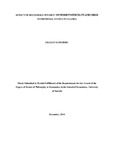| dc.description.abstract | This thesis investigates the effect of poverty on health status in Uganda. First, we test for the
effect of poverty on fertility, second for the effect of poverty on child nutritional status, and
finally, whether the effect of poverty on child nutritional status varies by gender of
household head. Poverty is proxied by wealth index of a household. Fertility, a proxy of
women’s reproductive health is measured by the number of children ever born (CEB), while
child nutritional status, an indicator of child health, is measured by the children’s height-forage
Z-scores (HAZ) and the probability of a child being stunted.
The thesis uses two nationally representative data sets, the Uganda Demographic and Health
Survey (UDHS) for 2006, and the Uganda National Household Survey (UNHS) for
2005/2006. Various estimation methods are employed. The Ordinary Least Squares (OLS)
and Zero-Inflated-Poisson (ZIP) models are used for a reduced form fertility model. To
account for possible endogeneity of wealth index, the Instrumental Variable (IV) methods
are used, while the Control Function Approach (CFA) is used to account for potential
heterogeneity in the wealth-fertility relationship. Testing for the effect of wealth index on
child nutritional status is done using OLS and Probit models. To control for possible
endogeneity of wealth index in the child nutrition model, the IV and IVProbit models were
used for HAZ and the probability of a child being stunted respectively. The CFA is
employed to account for potential heterogeneity in the wealth-child nutritional status
relationship. In addition, the OLS, IV and CFA models are used when investigating whether
the effect of wealth index on child nutritional status varies by gender of household head.
The findings of the thesis indicate that wealth index is inversely correlated with fertility, but
positively affects child nutritional status. The use of professional care at birth improves child
nutrition. The IV results suggest that wealth index may not be endogenous in both the
fertility and child nutritional status models. The CFA results indicate the presence of
heterogeneity arising from unobservable determinants of fertility that may be correlated with
wealth index. A similar result is found in the wealth-child nutritional status relationship.
Results further suggest that wealth index is positively associated with child nutritional status
in both male and female-headed households. Another important finding is that using
professional care at birth decreases the likelihood of malnutrition more significantly in
female-headed households than in male-headed ones. We uncover no endogeneity and
heterogeneity issues in the wealth-child nutritional status relationship for both male and
female-headed households.
The findings of this thesis suggest that improvement in wealth status and higher female
education are likely to lower fertility and improve child nutritional status. The use of
professional care at birth, which may be a proxy of accessibility of healthcare services,
should also be promoted in different parts of the country in order to lower malnutrition in
children. However, there is need to eliminate the differences that prevail in the usage of
professional care at birth in male and female-headed households. | en_US |

